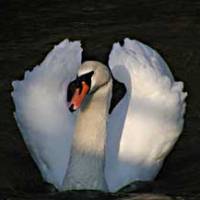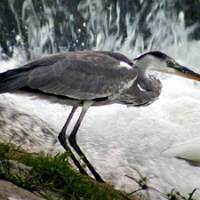* Japanese name: Aosagi
* Scientific name: Ardea cinerea
* Description: Gray herons, the largest of herons, grow to be almost 1 meter tall, with a wingspan of 2 meters. Despite their Japanese name (which means "blue heron"), these birds are more gray than blue, with a white neck and a black underside. The bill is yellow and they have a black "eyebrow." Males and females look the same. Young birds have black tufts on the nape of their necks.
* Where to find them: Gray herons breed in woodlands and plantations, usually near rivers and estuaries. They winter along rivers, estuaries, lakes, marshes, gravel pits and reservoirs and are commonly seen standing silent and statuesquely at the water's edge, waiting for prey. They can also be seen around fish farms and gardens and at temple ponds, much to the irritation of the monks. Herons aren't too fussy about the water they hunt in: It may be muddy or clear, salty or fresh -- so long as it contains fish.
* Food: Herons eat mainly fish, usually standing and waiting for their prey to swim close by. Then, the heron will rapidly straighten its neck and stab, sometimes more than once. Herons also stalk their prey, taking long strides through the water, sometimes wading out as deep as their belly (they have even been seen swimming). However, fish are not their only prey. If times are hard, herons will eat other birds and even mice, rats and water voles.
* Special features: From February, the herons' elaborate breeding rituals begin. The birds can be seen chasing each other through the air, and displaying to each other on old nest platforms, combining complex neck movements with the raising and lowering of the plumes on their crest and neck. The display looks like, and probably is, a kind of bird sign-language. Sound also plays a part: The birds snap their bills and produce ear-splitting cries. For a short period of time, too, their pale yellow legs and bills turn deep orange. A pair of herons produce 3-4 chicks per clutch; the young take seven weeks to grow big enough to fledge and leave the nest, and during that time they make an almost constant clicking noise. The adults, which can live to the age of 25, must be glad to see the back of them!
11 mins ago


















With your current subscription plan you can comment on stories. However, before writing your first comment, please create a display name in the Profile section of your subscriber account page.